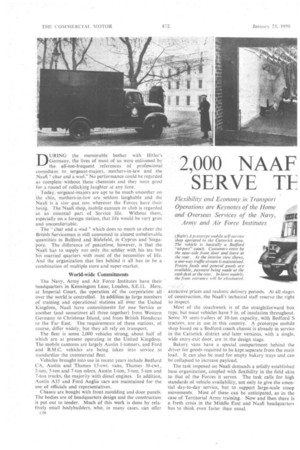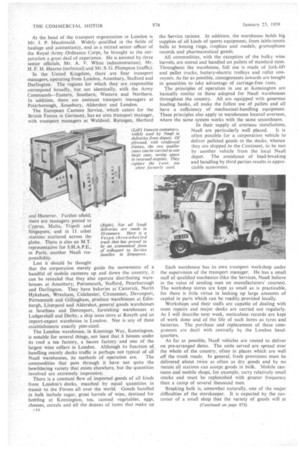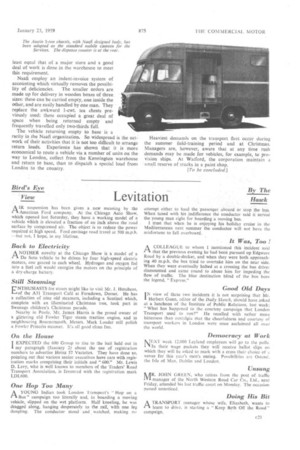2,000 NAAF SERVE TF EHICLES FORCES
Page 52

Page 53

Page 54

Page 57

If you've noticed an error in this article please click here to report it so we can fix it.
By Tom Waikerley
DURING the memorable bother with Hitler'S Germany, the lives of rnoSrof "us were enlivened "by. the all-too-frequent . 'references . of professional comedians to sergeant-majors, -mothers-in-law and the Naafi '-' char and a wad." No performance could be regarded as complete: without these chestnuts and' they were good for a round of rollicking laughter at any time: : Today, sergeant-majors-are apt to be much smoother on the chin,: rnotherssin-law are seldom laughable and the Naafi is a' .tirre qua 11011 wherever the Forces have their being. The Naafi shop, Mobile canteen or club is regarded as an essential part. of Service life. Without them, especially on a foreign station, that life would be very grim and uncomfortable.
. The "char and a wad." which does so much to cheer the British Serviceman is still consumed in aImOst unbelievable quantities. in BuIford and Bielefeld, in Cyprus and Singapore. The difference of peacetime, however, is that the Naafi has to supply not only the soldier with his tea but his married . quarters with most of the necessities of life. And the organization that lies behind it all has to be a combination of multiple store and super-market.
World-wide Commitments The Navy, Army and Air Force Institutes have their headquarters in Kennington Lane, London, S.E.H. .Here, at Imperial Court, the operation of the corporation all over the world is controlled. In addition to large numbers of training -aridofteraticinal stations all over the United Kingdom, Naafihave commitments for one Service or another (and sometimes all three together) from Western Germany to Christmas Island, and from British Honduras to the Far East. The requirements of these stations, of course, differ widely, but they all rely on transport.
The fleet is some 2,000 vehicles strong, about half of which are at present operating in the United Kingdom. The mobile canteens are largely Austin 1-tonners, and Ford and B.M.C. vehicles are being taken into service to standardize the commercial fleet. .
Vehicles brought into use in recent years include Bedford CA, Austin and Thames 15-cwt. vans, Thames 30-cwt., 2-ton, 5-ton and 7-ton oilers, Austin 1-ton, 3-ton, 5-ton and 7-ton trucks, the majority with diesel engines. In addition, Austin A35 and Ford Anglia -cars are maintained for the use of officials and representatives.
Chassis are bought with front moulding and door panels. The bodies are of headquarters design and the construction is put out to tender. Much of this work is done by relatively small bodybuilders, who, in many cases, can offer c16 attractive prices and realistic delivery periods. At all stages of construction, the Naafi's technical staff reserve the right to inspect.
Most of the coachwork is of the straightforward box type, but meat vehicles have 5 in. of insulation throughout. Some 30 semi-trailers of 10-ton capacity, with Bedford S tractors, are in use in this country. A prototype mobile shop based on a Bedford coach chassis is already in service in the Cattericic district and later versions, with a single, wide entry-exit door, are in the design stage.
Bakery vans have a special compartment behind the driver for goods required to be kept separate from the main load. It can also be used for empty bakery trays and can be collapsed to increase payload.
The task imposed on Naafi demands a solidly established base organization, coupled with flexibility in the field akin to that of the Forces it serves. The task calls for high standards of vehicle availability, not only to give the essential day-to-day service, but to support large-scale troop movements.. Most of these can be anticipated, as in the ease of Territorial Army training. Now and then there is
a fresh crisis. id the Middle East and Naafi headquarters has to think even faster than usual.
At the head of the transport organization in London is Mr. J. P. Macdonald. Widely qualified in the fields of haulage and accountancy, and as a retired senior officer of the Royal Army Ordnance Corps, he brought to the corporation a great deal of experience. He is assisted by three senior officials, Mr. A. V. White (administration), Mr. H. F. H. Hearne (technical) and Mr. S. G. Plumpton (traffic).
In the United Kingdom, there are four transport managers, operating from London, Amesbury, Stafford and Darlington. The regions for which they are responsible correspond broadly, but not identically, with the Army Commands—Eastern, Southern, Western and Northern. In addition, there• are assistant transport managers at Peterborough, Amesbury, Aldershot and London.
The European Canteen Service, which caters for the British Forces in Germany, has an area transport manager, with transport managers at Waldniel, Ratingen, Herford and Hanover. Farther afield, there are managers posted to Cyprus, Malta, Tripoli and Singapore, and in 11 other stations scattered across the globe. There is also an M.T. representative for S.H.A.P.E., in Paris, another Naafi responsibility.
Lest it should be thought that the corporation merely guide the movements of a handful of mobile canteens up and down the country, it can be revealed that they also operate distributing warehouses at Amesbury, Portsmouth, Stafford, Peterborough and Darlington. They have bakeries at Catterick, North Hykeharn, Wrexham, Colchester, Cirencester, Devonport, Portsmouth and Gillingham, produce warehouses at Edinburgh, Liverpool and Aldershot, general goods warehouses at Southsea and Devonport, furnishing warehouses at Ludgershall and Derby, a ship issue store at Rosyth and an import-export warehouse in London. Nor is any of these establishments exactly pint-sized.
The London warehouse, in Kennings Way, Kennington, is notable for several things, not least that it houses under its roof a tea factOry, a bacon factory and one of the largest wine cellars in London. Although its function of handling mainly docks traffic is perhaps not typical of all Naafi warehouses, its methods of operation are. The commodities that pass through it have not quite the bewildering variety that exists elsewhere, but the quantities involved are extremely impressive.
There is a constant flow of imported goods of all kinds from London's docks, matched by equal quantities in transit to the 'Forces all over the world. Goods handled in bulk include sugar, great barrels of wine, destined for bottling at Kennington, tea, canned vegetables, eggs, cheeses, cereals and all the dozens of items that make up
the Service rations. In addition, the warehouse holds big supplies of all kinds of sports equipment, from table-tennis balls to boxing rings, trophies and medals, gramophone records and pharmaceutical goods.
All commodities, with the exception of the bulky wine barrels, are stored and handled on pallets of standard sizes. Throughout the warehouse, full use is made of fork-lift and pallet trucks, battery-electric trolleys and roller conveyors. As far as possible, consignments inwards are bought in quantities to take advantage of carriage-free rates.
The principles of operation in use at Kennington are basically similar to those adopted for Naafi warehouses throughout the country. All are equipped with generous loading banks, all make the fullest use of pallets and all have a sufficiency of mechanical-handling equipment. These principles also apply to warehouses located overseas, where the same system works with the same smoothness.
In their supply Of overseas installations, Naafi are particularly well placed. It is often possible for a corporation vehicle to deliver palleted goods to the docks, whence they are shipped to the Continent, to be met by another vehicle from the local Naafi depot. The avoidance of load-breaking and handling by third parties results in appreciable economies.
Each warehouse has its own transport workshop under the supervision of the transport manager. He has a small staff of qualified mechanics (like the Services, Naafi believe in the value of sending men on manufacturers' courses). The workshop stores are kept as small as is practicable, for there is little virtue in locking up large amounts of capital in parts which can be readily provided locally.
Workshops and their staffs are capable of dealing with most repairs and major docks are carried out regularly. As I will describe next week, meticulous records are kept of work done and of the life of such items as tyres and batteries. The purchase and replacement of these components are dealt with centrally by the London headquarters.
As far as possible, Naafi vehicles are routed to deliver on pre-arranged dates. The units served are spread over the whole of the country, often in places which are well off the trunk roads. In general, fresh provisions must be delivered about twice as often as dry goods and by no means all stations can accept goods in bulk. Mobile canteens and mobile shops, for example, carry relatively small stocks and must be replenished with greater frequency than a camp of several thousand men.
Breaking bulk is, somewhat naturally, one of the major difficulties of the storekeeper. It is expected by the customer of a small shop that the variety of goods will at least equal that of a major store and a good deal of work is done in the warehouse to meet this requirement.
Naafi employ an indent-invoice system of accounting which virtually removes the possibi lity of deficiencies. The smaller orders are made up for delivery in wooden boxes of three sizes: these can be carried empty, one inside the other, and are easily handled by one man. They replace the awkward 1-cwt. tea chests previously used: these occupied a great deal of space when being returned empty and frequently travelled only two-thirds full.
The vehicle returning empty to base is a rarity in the Naafi organization. So widespread is the network of their activities that it is not too difficult to arrange return loads. Experience has shown that it is more economical to route a vehicle via a number of units on the. way to London, collect from the Kennington warehouse and return to base, than to dispatch a special load from London to the country. Heaviest demands on the transport fleet occur during the summer field-training period and at Christmas. Managers are, however, aware that at any time rush demands may be made for vehicles, for example, to provision ships. At Watford, the corporation maintain a small reserve of trucks in a paint shop.




































































































































































































